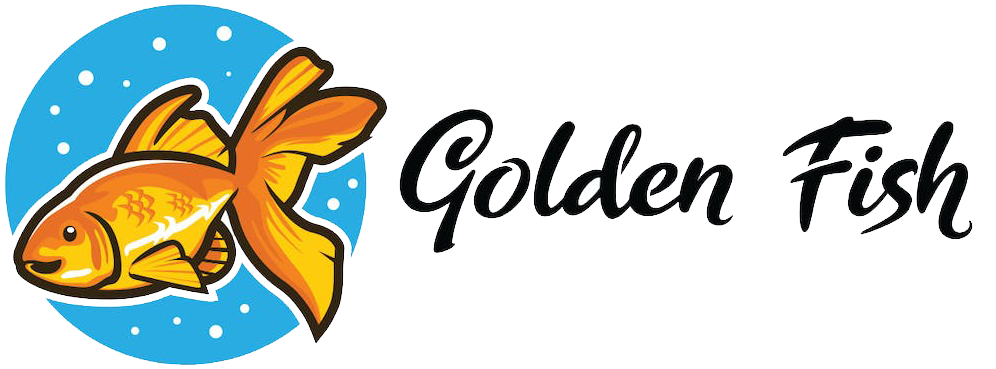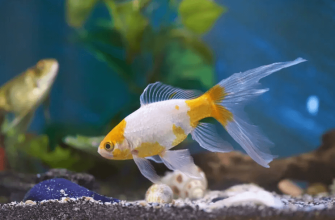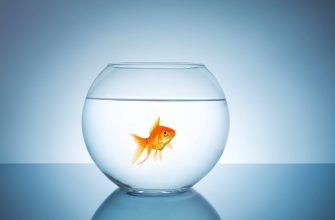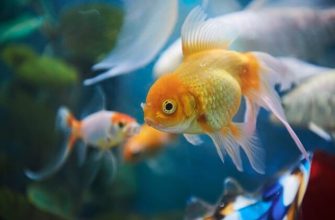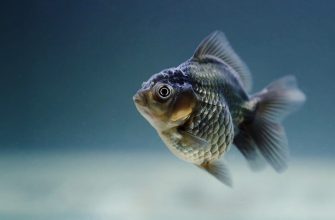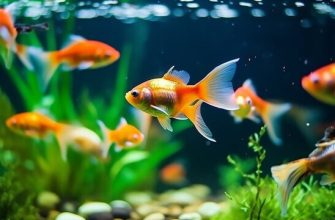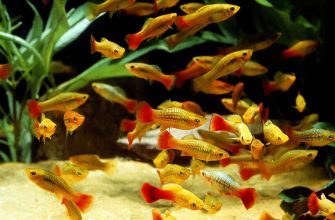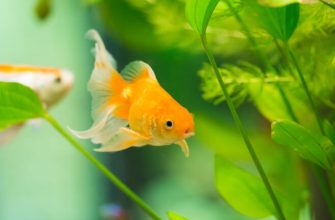Breeding goldfish can be a rewarding experience for aquarists looking to expand their aquarium hobby. While goldfish breeding may seem complex, with the right knowledge and preparation, it can be an exciting and fulfilling endeavor.
If you’re wondering how to breed goldfish, you’ve come to the right place! This guide will walk you through the essentials of goldfish breeding, from setting up the breeding tank to caring for the fry.
Choosing Goldfish for Breeding
When choosing goldfish for breeding, it is important to select mature, healthy fish with good genetics and temperament. The male and female should be similar in size and body type to ensure successful spawning. Opt for breeds with long, flowing fins like Comets, Fantails and Orandas. Avoid short-bodied fancy varieties like Ryukins initially.
Select fish that exhibit vibrant coloration and are active swimmers. Check for any signs of illness or disease. The breeding candidates should have a rounded, thick body shape which indicates good health and nutrition level. Their fins should be in excellent condition with no fraying or tears.
Pay attention to color patterns too. Goldfish with brighter, more intense colors often make the best parents. However, color preferences are largely subjective so focus more on health.
Research the bloodlines if possible to avoid inbreeding defects later on. Pick unrelated fish, ideally from different sources. Certain fin and body shapes breed true so factor genetics into your pairing selections.
Also ensure the chosen fish have a docile temperament. Aggressive or skittish goldfish may eat their own eggs, harm their mates or become easily stressed. Calm, mellow goldfish make ideal breeders.
Setting Up the Breeding Tank
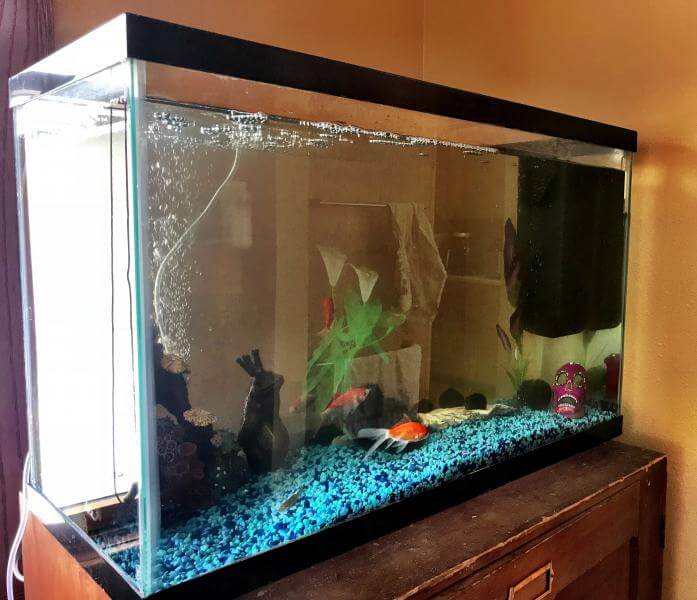
Setting up the right tank environment is crucial for successfully breeding goldfish. The breeding tank should be at least 20-30 gallons to provide adequate space for spawning and egg scattering. The tank should have gentle filtration to circulate the water without disrupting the eggs. Undergravel filters work well. The water temperature should be between 68-74°F and the pH between 7.0-8.0.
The tank should have minimal decorations and plants to provide clear space for breeding. Plastic plants can be used instead of live plants to avoid issues with goldfish eating the plants. The bottom of the tank can be left bare or lined with marbles to allow the eggs to fall through and avoid getting eaten. No gravel or substrate should be used as this can trap the eggs.
Preparing Goldfish for Breeding
Properly conditioning goldfish before breeding is critical to success. Goldfish that are in peak health and condition will be more likely to spawn successfully. Begin conditioning 6-8 weeks before attempting to breed.
-
Provide goldfish a nutritious diet high in protein. Feed foods like bloodworms, brine shrimp, and high quality flakes/pellets. This helps goldfish develop strong, healthy eggs.
-
Maintain excellent water quality, performing regular partial water changes. Water should be 68-72°F.
-
Give goldfish plenty of room to swim and exercise in the conditioning tank.
-
Male goldfish that are ready to spawn will start chasing females and bumping them. Females will look fuller-bodied when carrying eggs.
-
Once males are actively chasing and females look egg-laden, they can be moved to the breeding tank to encourage spawning.
Initiating Spawning
Goldfish will typically spawn naturally when conditions are right, but you can also initiate spawning manually. Look for signs that your goldfish are ready to spawn like tubercles developing on the males and a swollen abdomen on the females. To encourage natural spawning, try triggering behaviors like changing the water temperature, adjusting lighting, or simulating rainfall. The male will start chasing the female and nudging her abdomen when ready to spawn.
For manual spawning, identify a ripe female and isolate her in a separate tank. Hold the female upside down and gently squeeze the abdomen to release eggs into a bowl. Collect milt from a male the same way and mix with the eggs to fertilize them. Some breeders recommend hormone injections to induce spawning but this can be stressful for the fish. Whether spawning naturally or manually, provide dense plants for the female to lay eggs on. Once spawning is complete, return the goldfish to the main tank and transfer the fertilized eggs to a hatching tank.
Goldfish Egg Development

Goldfish eggs require specific water parameters to develop and hatch successfully. The water should be around 70-75°F with a pH between 7.0-8.0. Proper water parameters provide the ideal environment for fertilized eggs to mature.
After goldfish mate, the eggs are fertilized externally by the male. The eggs are adhesive and will stick to surfaces in the tank. Once attached, fertilized goldfish eggs take 2-7 days to hatch depending on the water temperature. Warmer water speeds up the incubation period.
During incubation, the eggs will turn from transparent to opaque as the embryo develops inside. Monitor the eggs closely for fungal infections which can kill the developing fry. Healthy eggs will hatch into free-swimming fry ready to begin feeding.
Caring for Goldfish Fry
Once the goldfish eggs hatch, the tiny fry will need special care and attention. It’s best to set up a separate tank just for the fry, as they are extremely small and vulnerable when first hatched. The fry tank should be around 10-20 gallons and equipped with a sponge filter to avoid sucking up the babies. The water should be kept very clean with frequent partial water changes.
Newly hatched goldfish fry are less than a quarter inch long and need to be fed infusoria or powdered fry food multiple times a day. Infusoria can be harvested from a mature tank or purchased as a powder. As the fry grow over the first few weeks, they can be transitioned to newly hatched brine shrimp. After 3-4 weeks, the juvenile fish will be large enough for crushed flake foods.
In the first month, goldfish fry go through a period of rapid growth. Their yolk sacs provide initial nourishment, then they will double in size within two weeks after hatching. By 6-8 weeks, body proportions will start to resemble juvenile goldfish. Monitor water quality diligently during this critical developmental period. With proper care and feeding, young goldfish will thrive.
Feeding the Fry
Newly hatched goldfish fry do best on a diet of small live foods like infusoria, microworms, vinegar eels, and brine shrimp nauplii. These tiny organisms allow the fry to easily consume and digest them. As the fry grow over the first 2-4 weeks, they can be transitioned to finely crushed flake foods and micro pellets.
When feeding newly hatched fry, they should be given small amounts of food 3-5 times per day. Only feed enough that they can consume within a few minutes, being careful not to foul the water with uneaten food. As the fry grow, the feeding frequency can be reduced to 2-3 times daily. Carefully monitor the fry during feedings and adjust the amount to match their appetite and growth rate. With proper feeding, goldfish fry can grow rapidly in the first few weeks to months.
Monitoring Goldfish Growth
Monitoring the growth and development of goldfish fry is an important part of breeding healthy fish. Goldfish grow rapidly in the first 8 weeks, with body length increasing an average of 27% per week. This means fry can more than double in size each week!
Signs of healthy growth include increased body size, bright colors, and active swimming and feeding. Goldfish fry should develop proportional bodies, clear eyes, and strong fins. Monitor for any signs of deformities, lethargy, lack of appetite, or abnormal swimming which could indicate issues.
Goldfish can be moved to the main tank once they are about 1.5 inches long and 8 weeks old. At this point, they are past the most vulnerable stage and less likely to be eaten or outcompeted by mature goldfish. Ensure the main tank has appropriate hiding spots and is not overcrowded. Continue monitoring growth rates and health after transferring to the main tank. With good care and feeding, goldfish can reach full adult size within their first year.
Common Breeding Issues

Goldfish breeding can sometimes encounter problems that prevent successful spawning or raising of fry.
Some common issues and solutions include:
-
Infertility – Older goldfish may be past their reproductive prime. Select young, healthy fish for breeding. Ensure water parameters like temperature are optimal.
-
Egg Fungus – Fungal infections can destroy goldfish eggs. Maintain excellent water quality and use a spawning mop to minimize fungus. Add antifungal treatments if needed.
-
Fry Death – Goldfish fry are delicate and can die from poor water quality, improper feeding, genetics and disease. Maintain pristine water parameters and feed a variety of live foods frequently. Cull weak fry.
-
Water Parameters – Incorrect temperature, pH, ammonia levels etc. can prevent spawning or kill eggs/fry. Research and maintain optimal water conditions. Perform frequent testing and water changes.
-
Nutrition Deficiencies – A nutritionally incomplete diet can impact breeding success. Feed a varied diet with live and frozen foods. Supplement with spirulina and vitamins.
-
Inbreeding – Breeding closely related fish can cause inbreeding depression, reducing viability. Introduce new stock periodically. Cull deformed/weak offspring.
Proper goldfish selection, tank setup, and care is key for avoiding common breeding problems. Research best practices and monitor fish and water parameters closely.
Continuing the Goldfish Line
Once you have successfully raised a spawn of goldfish fry to adulthood, you may wish to continue breeding your goldfish line.
There are a few key considerations for maintaining genetic diversity and breeding quality in future generations:
Selecting the Best Fry as Future Breeding Stock
When the fry reach maturity after 1-2 years, you will want to select the best specimens from that spawn to use for future breeding. Choose fish that exhibit good body shape, finnage, coloration and overall health. You want fish free from any spinal or swim bladder deformities. Select both males and females, ideally ones that are not closely related. The breeders stars or white dots on the pectoral fins can help identify quality mature males.
Culling Considerations for Genetic Health
While you want to select the best fry as future breeders, you also need to cull or remove less desirable fry from the gene pool. Deformities, poor color, undersized fish or other issues can be genetic so you don’t want those fish breeding. Culling helps maintain traits like body shape and finnage in your goldfish line. You may keep less desirable fish as pets, but avoid breeding them.
Recordkeeping for Spawns and Family Lines
Detailed recordkeeping is essential for a quality goldfish breeding program. Document when fish are spawned, who the parents are, how many fry survived, key traits, any issues, and more. When mature fry are selected as breeders, note their parentage and keep family trees. Records help manage genetics and allow selective breeding over generations.
